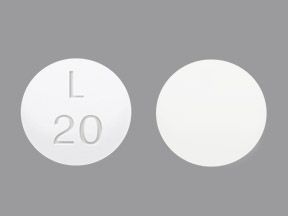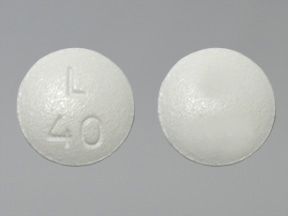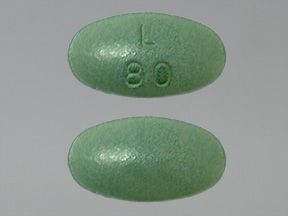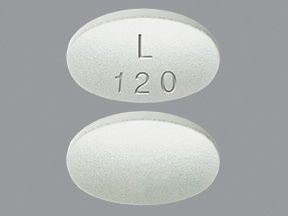Latuda (lurasidone) is a prescription drug that’s used to treat schizophrenia and depressive episodes related to bipolar I disorder. The drug comes as an oral tablet. It’s usually taken once per day.
Latuda is used to treat the following conditions:
- schizophrenia in adults and children ages 13 years and older
- depressive episodes related to bipolar I disorder in adults and children ages 10 years and older
- depressive episodes related to bipolar I disorder in adults, as an adjunct (add-on) medication with lithium or valproate
The active ingredient in Latuda is lurasidone. (An active ingredient is what makes a drug work.)
Latuda belongs to a group of drugs called antipsychotics.
This article describes the dosages of Latuda, as well as its strengths and how to take it. To learn more about Latuda, see this in-depth article.
Latuda Images
This section describes Latuda’s recommended dosages.
What is Latuda’s form?
Latuda comes as a tablet that you take by mouth, usually with food.
What strengths does Latuda come in?
Latuda comes in five strengths:
- 20 milligrams (mg)
- 40 mg
- 60 mg
- 80 mg
- 120 mg
What are the typical dosages of Latuda?
Typically, your doctor will start you on a low dosage. Then they’ll adjust your dosage over time to reach the right amount for you. Your doctor will ultimately prescribe the smallest dosage that provides the desired effect.
The information below describes dosages that are commonly used or recommended. But be sure to take the dosage your doctor prescribes for you.
Depending on your condition, your doctor might prescribe Latuda by itself or with other medications. They can advise you on what the dosages of these other medications would be.
Below is a dosage guide for starting dosages and recommended dosage ranges for the conditions Latuda treats. Doses are given in mg.
| Condition | Starting dosage | Recommended dosage |
|---|---|---|
| schizophrenia in adults | 40 mg once daily | 40–160 mg once daily |
| schizophrenia in children (ages 13–17 years) | 40 mg once daily | 40–80 mg once daily |
| bipolar depression in adults* | 20 mg once daily | 20–120 mg once daily |
| bipolar depression in children (ages 10–17 years) | 20 mg once daily | 20–80 mg once daily |
* The dosage range for this use is the same when Latuda is taken on its own or with lithium or valproate.
Dosage for schizophrenia
Latuda is approved to treat schizophrenia in adults and children ages 13 years and older.
The recommended starting dosage for schizophrenia is 40 mg once daily. The recommended dose range is 40–160 mg for adults. (For children’s dosage, see “What’s the dosage of Latuda for children?” below.)
Your doctor may increase your dose if the starting dose isn’t helping with your condition. Note that there is no average dose for schizophrenia, as the drug affects individuals differently. You should take the dose that’s recommended by your doctor.
Dosage for depressive episodes related to bipolar I disorder
Latuda is approved to treat major depressive episodes related to bipolar I disorder in adults and children ages 10 years and older. It’s not approved for use in people with bipolar II disorder.
For bipolar depression in adults, Latuda can be taken on its own or as an adjunct (add-on) medication with valproate or lithium.
The recommended starting dosage for bipolar depression is 20 mg once daily. The recommended dose range is 20–120 mg for adults. (For children’s dosage, see “What’s the dosage of Latuda for children?” below.)
Your doctor may increase your dose if the starting dose isn’t helping with your condition. Note that there is no average dose for bipolar depression, as the drug affects individuals differently. You should take the dose that’s recommended by your doctor.
When should I take Latuda?
You should take Latuda once each day, with food. You can take the medication any time throughout the day. But it’s usually best to take it around the same time each day.
You should take Latuda with food that’s at least 350 calories. So you may want to take Latuda after a meal. This helps your body absorb the drug better.
If you need help remembering to take your dose of Latuda on time, try using a medication reminder. This can include setting an alarm or downloading a reminder app on your phone.
Is Latuda used long term?
Yes, Latuda is typically used as a long-term treatment. If you and your doctor determine that Latuda is safe and effective for you, it’s likely that you’ll take it long term.
What’s the dosage of Latuda for children?
Latuda is approved to treat schizophrenia in children ages 13 years and older. The starting dose for schizophrenia is 40 mg. In children, the dose range for schizophrenia is between 40 mg and 80 mg. Your child’s doctor may recommend a Latuda dose increase if the starting dose isn’t effective for your child.
To treat depressive episodes related to bipolar I disorder, Latuda is approved for children ages 10 years and older. The starting dose for bipolar depression is 20 mg. In children, the dose range for bipolar depression is between 20 mg and 80 mg. Your child’s doctor may recommend a Latuda dose increase if the starting dose isn’t effective for your child.
Dosage adjustments
If you have certain medical conditions or are taking certain drugs, your doctor may suggest you take a dose of Latuda that’s different from what’s typically recommended. This is to help make sure the drug is working effectively and to lower the risk of side effects.
Adjustments for medical conditions
If you have liver or kidney problems, the recommended starting dose for any condition Latuda treats is 20 mg once daily. And the maximum recommended dose is 80 mg. If you have severe liver problems, the maximum recommended dose is 40 mg.
Adjustments for medications
If you take certain medications that interact with Latuda, you’ll need an adjustment to your dose of Latuda.
Some medications affect an enzyme called CYP3A4, which is responsible for breaking down Latuda. Drugs that block CYP3A4 (CYP3A4 inhibitors) increase the level of Latuda in your body. Some drugs can increase CYP3A4 in your body (CYP3A4 inducers), which decreases the level of Latuda.
Tell your doctor about any medications you’re taking. This will help them to determine the right dose of Latuda for you.
To learn more about the drugs that could interact with Latuda, see this in-depth article on the drug.
If you miss a dose of Latuda, take it as soon as you remember. If it’s almost time for your next dose, skip the missed dose and take your next dose at the usual time. Don’t take two doses to make up for the missed dose. This increases your risk for side effects.
If you need help remembering to take your dose of Latuda on time, try using a medication reminder. This can include setting an alarm or downloading a reminder app on your phone.
The dosage of Latuda you’re prescribed may depend on several factors. These include:
- the type and severity of the condition you’re using Latuda to treat
- your age
- other conditions you may have and other medications you may be taking (see “Dosage adjustments” under “What is Latuda’s dosage?”)
You should take Latuda with food. Specifically, the food you take with the drug should contain at least 350 calories. This helps your body absorb the drug better.
Swallow Latuda tablets whole. Don’t crush, break, or chew them.
Avoid grapefruit and grapefruit juice, as they may interact with Latuda and raise the level of the drug in your body.
Latuda hasn’t been studied for misuse, and it isn’t a controlled substance. (The United States government regulates the use of controlled substances.)
In studies of Latuda, there were no reports of behaviors that indicate dependence on this drug. But if you have a history of drug misuse, talk with your doctor before starting treatment with Latuda.
Do not use more Latuda than your doctor prescribes. Using more than this can lead to serious side effects.
What to do in case you take too much Latuda
Call your doctor right away if you think you’ve taken too much Latuda. You can also call 800-222-1222 to reach America’s Poison Centers or use its online resource. But if you have severe symptoms, call 911 (or your local emergency number) immediately or go to the nearest emergency room.
The sections above describe the typical dosages provided by the drug’s manufacturer. If your doctor recommends Latuda for you, they will prescribe the dosage that’s right for you.
Remember, you should not change your dosage of Latuda without your doctor’s approval. Only take Latuda exactly as prescribed. Talk with your doctor if you have questions or concerns about your current dosage.
Here are some examples of questions you may want to ask your doctor:
- How will my Latuda dose change if I’m taking other medications?
- Are there any foods or supplements I should avoid while taking Latuda?
- Does my dosage of Latuda need to change if I have certain health conditions?
To learn more about Latuda, see these articles:
- All About Latuda
- Latuda Interactions: Alcohol, Medications, and Others
- Latuda vs. Abilify: What You Should Know
- Side Effects of Latuda: What You Need to Know
To get information on different conditions and tips for improving your health, subscribe to any of Healthline’s newsletters. You may also want to check out the online communities at Bezzy. It’s a place where people with certain conditions can find support and connect with others.
Q:
How will I know if I need a change in my dose of Latuda?
AnonymousA:
Typically, your doctor will start you on a low dosage of Latuda. If your symptoms increase or don’t lessen for the condition you’re being treated for, your doctor will likely increase the dosage of Latuda.
If you experience any side effects while taking Latuda, your doctor will likely decrease your dosage.
It’s important that you tell your doctor if you experience worsening of symptoms of your condition or if you develop side effects while taking Latuda.
It’s also important that you do not change your dosage without your doctor’s recommendation. Be sure to take the dosage they prescribe for you.
The Healthline Pharmacist TeamAnswers represent the opinions of our medical experts. All content is strictly informational and should not be considered medical advice.Disclaimer: Healthline has made every effort to make certain that all information is factually correct, comprehensive, and up to date. However, this article should not be used as a substitute for the knowledge and expertise of a licensed healthcare professional. You should always consult your doctor or other healthcare professional before taking any medication. The drug information contained herein is subject to change and is not intended to cover all possible uses, directions, precautions, warnings, drug interactions, allergic reactions, or adverse effects. The absence of warnings or other information for a given drug does not indicate that the drug or drug combination is safe, effective, or appropriate for all patients or all specific uses.




